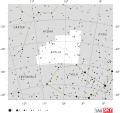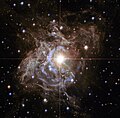 | of the class of classical Cepheid variables. The eponymous star for classical Cepheids, Delta Cephei, was discovered to be variable by John Goodricke... 37 KB (4,170 words) - 19:48, 20 April 2024 |
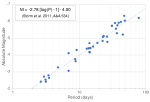 | Period-luminosity relation (category Classical Cepheid variables) pulsating variable stars with their pulsation period. The best-known relation is the direct proportionality law holding for Classical Cepheid variables, sometimes... 20 KB (2,319 words) - 18:00, 15 April 2024 |
 | Polaris (category Classical Cepheid variables) Population I classical Cepheid variable, although it was once thought to be a type II Cepheid due to its high galactic latitude. Cepheids constitute an... 48 KB (4,671 words) - 21:11, 11 May 2024 |
 | of the class of Cepheid variables. However, the namesake for classical Cepheids is the star Delta Cephei, discovered to be variable by John Goodricke... 50 KB (6,468 words) - 06:01, 22 April 2024 |
 | Zeta Geminorum (category Classical Cepheid variables) — in its south, on the left 'leg' of the twin Pollux. It is a classical Cepheid variable star, of which over 800 have been found in our galaxy. As such... 22 KB (2,165 words) - 21:21, 28 November 2023 |
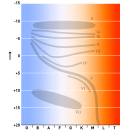 | have supergiant luminosity classes, for example α Herculis. Classical Cepheid variables typically have supergiant luminosity classes, although only the... 37 KB (5,067 words) - 17:09, 9 May 2024 |
 | and BL Herculis variables, the type II Cepheids. Classical Cepheid variables are higher mass population I stars. RR Lyrae variables are much more common... 16 KB (1,804 words) - 13:44, 29 August 2023 |
 | RS Puppis (category Classical Cepheid variables) Pup) is a Cepheid variable star around 6,000 ly away in the constellation of Puppis. It is one of the biggest and brightest known Cepheids in the Milky... 11 KB (1,084 words) - 21:39, 13 August 2023 |
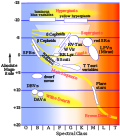 | Type II Cepheids are variable stars which pulsate with periods typically between 1 and 50 days. They are population II stars: old, typically metal-poor... 13 KB (1,227 words) - 14:49, 20 August 2023 |
 | Delta Cephei (category Classical Cepheid variables) the prototype of the Cepheid variable stars that undergo periodic changes in luminosity. Delta Cephei was discovered to be variable by John Goodricke during... 20 KB (1,671 words) - 23:37, 12 March 2024 |
300 and NGC 7793 in the Sculptor Group. The dynamical mass of a classical Cepheid variable star in an eclipsing binary system RR-Lyrae-type pulsations from... 3 KB (439 words) - 02:37, 4 August 2021 |
 | Milky Way. He used the strong direct relationship between a classical Cepheid variable's luminosity and pulsation period (discovered in 1908 by Henrietta... 49 KB (5,081 words) - 08:22, 12 May 2024 |
 | FF Aquilae (category Classical Cepheid variables) FF Aquilae is a classical Cepheid variable star located in the constellation Aquila. It ranges from apparent magnitude 5.18 to 5.51 over a period of 4... 10 KB (924 words) - 20:51, 12 August 2023 |
 | V Centauri (category Classical Cepheid variables) V Centauri (V Cen) is a Classical Cepheid variable, a type of variable star, in the constellation Centaurus. It is approximately 2,350 light-years (720... 7 KB (603 words) - 13:32, 26 November 2023 |
 | Cosmic distance ladder (section Classical Cepheids) of classical Cepheid variable stars. The following relation can be used to calculate the distance to Galactic and extragalactic classical Cepheids: ... 54 KB (7,874 words) - 13:49, 26 April 2024 |
 | RT Aurigae (category Classical Cepheid variables) supergiant variable star in the constellation Auriga, about 1,500 light years from Earth. RT Aurigae is an F to G type Classical Cepheid variable which varies... 11 KB (1,053 words) - 06:42, 16 November 2023 |
 | Y Carinae (category Classical Cepheid variables) Y Carinae (Y Car) is a Classical Cepheid variable, a type of variable star, in the constellation Carina. Its apparent magnitude varies from 7.53 to 8.48... 7 KB (585 words) - 16:27, 30 December 2023 |
 | Eta Aquilae (category Classical Cepheid variables) years, so η Aql would appear to be a triple system. η Aquilae A is a Cepheid variable star, discovered by Edward Pigott in 1784. It has an apparent magnitude... 16 KB (1,407 words) - 23:51, 16 March 2024 |
 | W Virginis variables are a subclass of Type II Cepheids which exhibit pulsation periods between 10–20 days, and are of spectral class F6 – K2. They were... 2 KB (179 words) - 14:49, 24 July 2021 |
 | V1334 Cygni (category Classical Cepheid variables) naked eye of an observer located far from city lights. It is a classical Cepheid variable star, ranging in brightness from magnitude 5.77 to 5.96 over a... 11 KB (948 words) - 05:03, 3 December 2023 |
 | X Crucis (category Classical Cepheid variables) X Crucis is a classical Cepheid variable star in the southern constellation of Crux. X Crucis is a pulsating variable star with am extremely regular amplitude... 7 KB (546 words) - 12:46, 14 May 2023 |
 | OGLE-LMC-CEP0227 (category Classical Cepheid variables) eclipsing binary and Cepheid variable star, pulsating every 3.8 days. The star, in the Large Magellanic Cloud, was the first Cepheid star system found to... 7 KB (509 words) - 10:46, 15 July 2022 |
 | S Crucis (category Classical Cepheid variables) F6Ib-II and G1Ib-II. S Crucis is a pulsating variable star of the δ Cephei type, a Classical Cepheid variable. Its mean radius is 37.9 R☉ and that radius... 6 KB (456 words) - 23:00, 11 April 2024 |
(June 2008). "The Luminosities and Distance Scales of Type II Cepheid and RR Lyrae variables". Monthly Notices of the Royal Astronomical Society. 386 (4):... 40 KB (3,575 words) - 00:16, 13 March 2024 |
 | HD 95109 (category Classical Cepheid variables) a Classical Cepheid variable, a type of variable star, in the constellation Carina. Its apparent magnitude is 6.86. U Car is a δ Cepheid variable with... 7 KB (505 words) - 22:59, 11 April 2024 |


